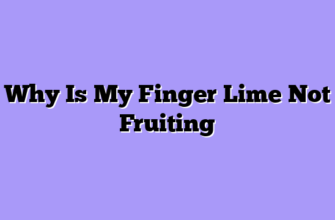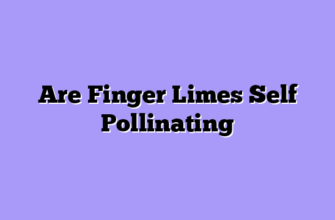You know what changed my entire perspective on growing Australian finger limes? The day I realized I didn’t need acres of land to cultivate these incredible citrus caviar plants successfully. Standing on my friend’s tiny apartment balcony, staring at her thriving potted Citrus australasica loaded with fruits, I had an epiphany. These native Australian beauties are actually phenomenal container candidates—arguably better suited to pot culture than many other citrus varieties I’ve worked with.
Let me share everything I’ve learned about growing bush limes in containers, because honestly, this approach has revolutionized how I think about small-space fruit production. Whether you’ve got a cramped patio, a sunny balcony, or you’re dealing with challenging climates that require bringing plants indoors, container growing might be your perfect solution.
Why Finger Limes Thrive in Container Culture
Here’s something that surprised me when I first started experimenting with potted caviar limes: they don’t just tolerate containers—they actually seem to prefer them in many situations. Unlike some fruit trees that sulk in pots, finger lime trees adapt remarkably well to restricted root environments.
The natural growth habit of Citrus australasica makes them ideal pot candidates. In their native Australian rainforest understory, these bush lemons evolved as relatively compact plants, usually growing as shrubs or small trees rather than massive specimens. This genetic predisposition toward moderate size translates beautifully to container culture. Where an in-ground tree might eventually reach 10-12 feet, a potted specimen naturally stays around 4-6 feet tall—perfectly manageable for most spaces.
I’ve got sixteen different varieties growing in containers on my property, ranging from compact varieties in 15-gallon pots to more vigorous types in 30-gallon containers. My success rate with potted specimens actually exceeds my in-ground plantings when I factor in maintenance requirements and per-plant productivity. That’s not something I ever expected to say about a fruit tree.
The root restriction that comes with container growing has some fascinating effects on Australian finger limes. It tends to encourage earlier fruiting—I typically see blooms on potted plants within 2-3 years, compared to 3-4 years for in-ground specimens. The fruits are usually similar in size and quality to those from field-grown trees, though overall yield per plant is obviously lower due to the reduced tree size. Still, a healthy potted caviar lime can easily produce 40-80 fruits annually once established, which is impressive for something you can move around with a hand truck.
Advantages of Container Growing:
- Mobility: Move plants to optimize sun exposure, protect from extreme weather, or bring indoors during cold snaps
- Soil control: Create perfect growing medium regardless of native soil quality
- Pest management: Easier to inspect, treat, and isolate from infected plants
- Space efficiency: Grow multiple varieties in small areas impossible for in-ground planting
- Climate flexibility: Extend growing zones by providing winter protection
- Accessibility: Easier harvesting, pruning, and maintenance at manageable heights
- Urban gardening: Perfect solution for balconies, patios, and small yards
Container culture does require more attention than in-ground growing—there’s no getting around that reality. You’re committing to regular watering, consistent fertilization, and eventual root management. But for many growers, especially those with limited space or challenging climates, the tradeoffs are absolutely worthwhile.
Choosing the Right Container and Growing Medium
Let me tell you about my biggest early mistake with potted bush limes: I cheaped out on containers. I started with basic plastic nursery pots, thinking they’d work fine. Within two growing seasons, I was dealing with circling roots, poor drainage, and plants that looked stressed despite my best care. Investing in quality containers from the start would have saved me time, money, and frustration.
Container size is critical for citrus australasica success. I’ve tested everything from 10-gallon buckets to massive 45-gallon planters, and here’s what I’ve learned: bigger is usually better, but there’s a practical limit based on mobility and space. For most growers, I recommend starting with at least a 20-gallon container for a young plant, with plans to eventually transplant into 25-30 gallon pots as the tree matures.
The math is simple: each gallon of soil volume supports roughly 4-6 inches of tree height. Want a 5-foot finger lime? You need at least 20-25 gallons of growing medium. Trying to maintain a 6-foot specimen? Plan for 30 gallons minimum. I’ve pushed these ratios and consistently gotten disappointing results—stunted growth, poor fruit set, and stressed plants.
Material matters more than you might think. I’ve worked with plastic, ceramic, wood, and fabric containers for my caviar lime collection. Each has distinct advantages and drawbacks:
| Container Material | Durability | Weight | Drainage | Root Temperature | Cost | Best Use Case |
|---|---|---|---|---|---|---|
| Plastic (quality) | Excellent | Light | Good | Can overheat | Low-Moderate | Budget-friendly, mobility important |
| Ceramic/Terra Cotta | Moderate | Heavy | Excellent | Stays cool | Moderate-High | Aesthetic priority, stable location |
| Wood (cedar, redwood) | Moderate | Moderate-Heavy | Good | Excellent | Moderate | Natural look, good insulation |
| Fabric/Smart Pots | Good | Very Light | Excellent | Good | Low-Moderate | Air pruning roots, maximum drainage |
| Composite/Resin | Excellent | Light-Moderate | Good | Good | Moderate | Balance of features, modern look |
Drainage holes are absolutely non-negotiable. I don’t care how beautiful that decorative pot is—if it doesn’t have drainage, don’t use it for Australian finger limes. These native plants are remarkably drought-tolerant once established, but they’re extremely sensitive to waterlogged conditions. I drill extra holes in the bottom and lower sides of containers, ensuring water never accumulates.
The growing medium deserves as much attention as the container itself. Regular garden soil or even standard potting mix won’t cut it for bush lemons. These plants need exceptional drainage combined with good moisture retention—sounds contradictory, but it’s achievable with the right blend.
My proven mix for potted citrus australasica consists of:
- 40% quality commercial potting soil (provides base structure and some nutrients)
- 30% pine bark fines or coco coir (improves drainage while retaining moisture)
- 20% perlite or pumice (creates air spaces and prevents compaction)
- 10% compost or worm castings (adds nutrients and beneficial microorganisms)
- Optional additions: A handful of slow-release citrus fertilizer mixed in at planting
This blend has consistently outperformed both straight potting soil and overly drainage-focused mixes. The key is creating a medium that’s fluffy and well-aerated yet holds enough moisture that you’re not watering three times daily. When you squeeze a handful, it should hold together loosely but fall apart easily when disturbed.
I always wet the medium thoroughly before filling containers. Dry components, especially peat moss and coco coir, are hydrophobic and resist wetting once in the pot. I mix everything in a large tub or wheelbarrow, adding water gradually and working it in with my hands or a shovel until the entire batch is evenly moist.
Essential Care Practices for Potted Caviar Limes
Watering potted finger limes is both the most important and most challenging aspect of container culture. Unlike in-ground trees that can tap into soil moisture reserves, containerized plants depend entirely on you for water. Get this wrong—either overwatering or underwatering—and your caviar lime will suffer immediately.
I check my containers daily during warm weather, sometimes twice daily during heat waves. The top inch or two of growing medium should dry out between waterings, but the deeper layers should remain slightly moist. I use the finger test—literally sticking my finger into the medium about two inches deep. If it feels dry, I water. If it’s moist, I wait another day.

Here’s a watering tip that’s saved me countless stressed plants: use the container weight method. When properly watered, a 25-gallon pot with a mature finger lime weighs substantially more than when dry. After watering, I lift (or tilt) the container to feel its weight. Then I do the same thing when it’s due for water. You quickly develop a sense for when containers are getting light and need moisture.
Year-Round Container Care Schedule:
- Spring (active growth begins): Increase watering frequency, apply slow-release fertilizer, prune for shape, repot if needed
- Summer (peak growth and fruiting): Water frequently, possibly daily in extreme heat, apply liquid fertilizer monthly, monitor for pests
- Fall (fruit development): Continue regular watering, reduce fertilizer frequency, prepare for winter protection if needed
- Winter (dormant or slow growth): Reduce watering significantly, no fertilization, protect from freezing, provide supplemental light if indoors
Fertilization needs for potted bush limes differ significantly from in-ground plants. The limited soil volume means nutrients get depleted faster and can’t be replenished from surrounding soil. I use a two-pronged approach: slow-release granular fertilizer applied every 3-4 months, supplemented with liquid fertilizer during active growth.
I prefer fertilizers specifically formulated for citrus, with an NPK ratio around 6-4-6 or similar. The slightly higher nitrogen supports leaf growth, while adequate phosphorus and potassium promote flowering and fruit development. Micronutrients—especially iron, manganese, and zinc—are crucial for these Australian natives. Iron deficiency, showing as yellowing leaves with green veins, is common in container-grown citrus australasica.
My fertilization protocol starts conservatively and increases based on plant response. A young plant in a 20-gallon pot might get just 2 tablespoons of slow-release fertilizer in early spring, supplemented with diluted liquid feed monthly during summer. A mature specimen in a 30-gallon container could handle double that amount. I always err on the side of less rather than more—overfertilization causes more problems than slight underfeeding.
| Season | Watering Frequency | Fertilizer Type | Fertilizer Frequency | Special Considerations |
|---|---|---|---|---|
| Spring | Every 2-4 days | Slow-release + liquid | Slow: once; Liquid: bi-weekly | Resume feeding, increase water gradually |
| Summer | Daily to every 2 days | Liquid | Every 1-2 weeks | Peak water needs, watch for heat stress |
| Fall | Every 3-5 days | Reduce liquid, no slow-release | Monthly or less | Prepare for dormancy, reduce feeding |
| Winter | Every 5-10 days | None | Not at all | Minimal water, no fertilizer, protect from cold |
Sunlight requirements for potted caviar limes are straightforward: more is better, up to a point. These bush lemons need at least 6-8 hours of direct sun daily for optimal growth and fruiting. Less than that and you’ll get leggy growth, poor flowering, and minimal fruit set. I position my containers to maximize morning and midday sun while providing some afternoon shade during the hottest summer months.
The mobility advantage of containers really shines here. I literally rotate my plants throughout the growing season, following the sun’s changing angle. That southeast-facing spot perfect in spring might be too shaded by summer. The ability to move plants means I can optimize light exposure year-round.
Seasonal Management and Long-Term Success
Winter management separates successful container growers from frustrated ones. These Australian finger limes are subtropical to tropical plants, hardy only to about 28-30°F. In climates with occasional freezes, you’ve got options. I wheel my containers into an unheated garage or shed during cold snaps, then return them outside once temperatures moderate. Even a few degrees of protection can mean the difference between life and death for these native plants.
For growers in truly cold climates, bringing potted citrus australasica indoors for winter is entirely feasible. I’ve consulted with several northern growers who maintain beautiful specimens in sunny rooms or under grow lights throughout winter. The key is providing adequate light—at least 12-14 hours under artificial lights or placement in a bright, south-facing window.
Indoor overwintering does present challenges. Humidity drops significantly in heated homes, and finger limes don’t love dry air. I recommend misting plants regularly or using pebble trays—shallow trays filled with rocks and water that sit beneath the container, increasing local humidity as the water evaporates. Just ensure the pot sits on the rocks above water level, not in it.
Root management becomes necessary every few years with container-grown bush lemons. You’ll know it’s time when water runs straight through without absorbing, when growth slows despite good care, or when roots circle densely around the outside of the root ball. I typically root-prune my established plants every 3-4 years, removing about a quarter of the root mass and replacing the removed soil with fresh medium.
The root pruning process sounds intimidating but it’s actually straightforward. I remove the plant from its container (easier said than done with larger specimens—sometimes I need help), then use a sharp, clean knife to slice off an inch or two from the bottom and sides of the root ball. I score the remaining roots to encourage new growth, then replant in the same container with fresh medium. The plant might look stressed for a few weeks but always bounces back stronger.
Pest management in containers is generally easier than with in-ground plants. I can thoroughly inspect every leaf and branch, catching problems early. The most common issues I see are aphids on new growth, scale insects on stems and leaves, and occasionally spider mites. Isolation is simple—I just move the affected container away from others while treating the problem.
I prefer starting with the least toxic options: strong water sprays to dislodge aphids, manual removal of scale, or insecticidal soap for light infestations. For persistent problems, horticultural oil works well on caviar limes without harming the plant. Chemical pesticides are my absolute last resort, used only when nothing else works.
Pruning containerized finger limes serves multiple purposes: maintaining manageable size, encouraging bushier growth, and removing dead or damaged wood. I prune lightly throughout the growing season, removing wayward branches and thinning dense areas to improve air circulation. More significant pruning happens in late winter or early spring before new growth begins.
My pruning philosophy for potted Australian finger limes is “little and often” rather than dramatic cuts. I maintain my plants at 4-6 feet tall by simply removing any branches that exceed my target height. I encourage lateral branching by pinching or cutting the tips of upright shoots. The result is a dense, bushy plant that’s easy to manage and produces fruit within easy reach.
Here’s something interesting I’ve discovered through careful record-keeping: properly managed container specimens can be remarkably productive relative to their size. One of my 6-year-old plants in a 30-gallon pot consistently produces 60-75 fruits annually—not as many as an in-ground tree, obviously, but impressive considering I can move this tree around and bring it into protection when needed. The fruit quality is indistinguishable from field-grown specimens.
The investment in container growing Citrus australasica pays dividends beyond just fruit production. These plants are genuinely ornamental, with their unique foliage, interesting growth habit, and those remarkable cylindrical fruits. I’ve placed potted bush limes in high-visibility areas where they serve dual purposes—productive and decorative. Visitors always comment on them, and once they taste those citrus caviar pearls, they’re converted.
If you’re considering growing finger limes but thought you lacked the space or climate, I encourage you to try container culture. Start with a quality 20-25 gallon pot, use the growing mix I’ve outlined, and commit to consistent watering and feeding. Choose a variety suited to your space—Judy’s Everbearing and Collette are particularly good for pots due to their more compact nature. Position your container where it gets solid sun exposure, and you’ll be shocked at how well these Australian natives adapt to life in a pot. Trust me, once you harvest your first caviar limes from a plant you can move around like furniture, you’ll wonder why you didn’t start sooner.








